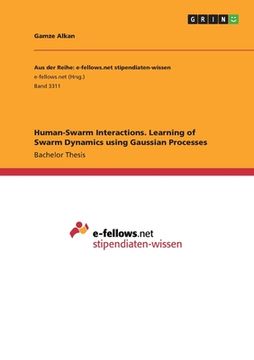Compartir
Human-Swarm Interactions. Learning of Swarm Dynamics using Gaussian Processes (en Inglés)
Gamze Alkan
(Autor)
·
Grin Verlag
· Tapa Blanda
Human-Swarm Interactions. Learning of Swarm Dynamics using Gaussian Processes (en Inglés) - Alkan, Gamze
S/ 308,24
S/ 513,74
Ahorras: S/ 205,49
Elige la lista en la que quieres agregar tu producto o crea una nueva lista
✓ Producto agregado correctamente a la lista de deseos.
Ir a Mis Listas
Origen: Estados Unidos
(Costos de importación incluídos en el precio)
Se enviará desde nuestra bodega entre el
Martes 16 de Julio y el
Jueves 25 de Julio.
Lo recibirás en cualquier lugar de Perú entre 2 y 5 días hábiles luego del envío.
Reseña del libro "Human-Swarm Interactions. Learning of Swarm Dynamics using Gaussian Processes (en Inglés)"
Bachelor Thesis from the year 2017 in the subject Engineering - Robotics, grade: 1,0, University of Stuttgart (Institut für Systemdynamik), language: English, abstract: Inspired by the natural flocking behavior of animals, scientists try to achieve similar advantages by using swarm robots to fulfill more complex tasks in an easier and more cost-efficient way. In order to understand the behavior of such a dynamic system and make predictions for future states, a sufficiently accurate model is necessary. However, the dynamics of the system such as the communication structure of the semi-autonomous multi-agent system in this thesis are sometimes unknown to the human. Thus, machine learning methods such as Gaussian Process Regression are applied in order to learn the system model. The influence of the collected training data on the accuracy of the learned model is analyzed for a linear and a nonlinear case of the system. Afterwards, the model is used to predict the future average positions in order to support the human operator to control the agents to a desired destination. In the setup regarded in this work, the human can control the velocity of a subset of robots, while all agents are supposed to move gathered by exchanging information such as their position within the neighbors. Finally, the system behavior is learned through training data collected in an experiment and analyzed in a simulation.
- 0% (0)
- 0% (0)
- 0% (0)
- 0% (0)
- 0% (0)
Todos los libros de nuestro catálogo son Originales.
El libro está escrito en Inglés.
La encuadernación de esta edición es Tapa Blanda.
✓ Producto agregado correctamente al carro, Ir a Pagar.

